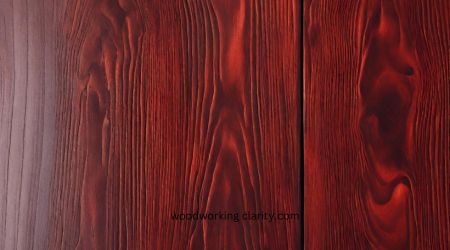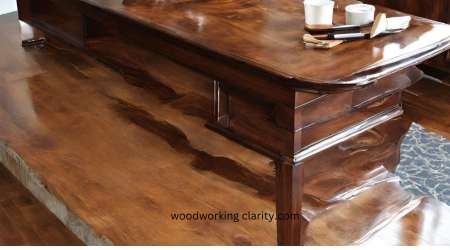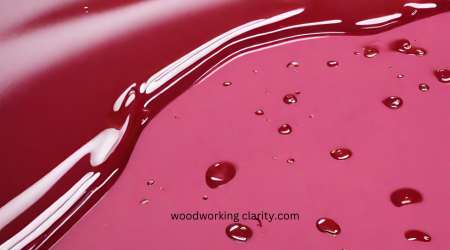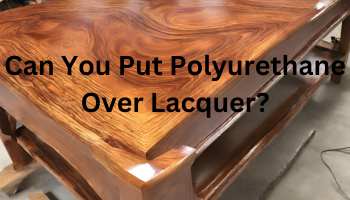I know it’s a common question, but I’m going to answer it anyway. Can you put polyurethane over lacquer?
The short answer is no; you cannot.
Polyurethane can react with the lacquer and produce an ugly finish. If you want to apply polyurethane over lacquered wood, you must sand off all existing finish down to bare wood.
Besides, you need to keep some things in mind before you start. For instance,
- The type of wood that’s already lacquered
- How much time do you want to spend on preparation work
- Safety precaution
Luckily, this post will go through all these considerations.
Let’s get started!
Can You Put Polyurethane Over Lacquer?
No, you can’t apply poly over lacquer as polyurethane won’t bond. The polyurethane coat will peel and flake over time. To protect your lacquer finish from water damages and scratches, apply alkyd varnish instead of polyurethane. Alkyd varnish is formulated with polyester resin to provide better adhesion and durability.
What Is Lacquer?

The word lacquer is generally used for glossy or semi-gloss finish applied to nonporous materials, including metal or wooden kitchen cabinets. These fall into several different categories.
The primary category of lacquer is made from dissolving nitrocellulose and plasticizers and pigments in volatile solid solvents.
Lacquer is also made with a solution of shellac in denatured alcohol to mimic the appearance of expensive wood finishes like cherry, mahogany, or walnut.
The finish protects wood from outdoor elements, like snow, rain, and heat.
The main feature of this type of paint is its smooth, shiny, and durable surface. In addition, it protects surfaces from scratches and abrasions caused by traffic, equipment, and grit.
Even better, lacquer finishes provide an excellent barrier against UV rays, making them ideal for outdoor structures and furniture.
How Many Coats of Lacquer Should I Apply to Wood?
In order to have the best longevity and protection, it is recommended to use at least three coats of lacquer. Be sure to sand in between each coat with fine-textured sandpaper. You will usually need 6-7 coats of lacquer when using a spray applicator.
The number of coatings would depend on some factors, including;
- How thin is each coat of laquer.
- Whether you’re going to spray or brush your laquer finish.
- The type of lacquer – the different types of lacquers available are either oil-based or acrylic-based. Each type of coating has different pros and cons when it comes to applying them to wood.
- Environmental factors such as humidity and temperature.
To get the actual number of coats needed, always read and follow the instructions on the label.
Read also: Can you apply polyurethane over polycrylic?
Can I Stain Over Lacquer Finishes?

Old lacquered furniture can often look very fragile and easy to damage. So you might be thinking of staining the surface for added protection.
If you try to put stain on a lacquered piece of furniture, the stain will form droplets and fall. To apply stain on a lacquered piece of wood furniture, you must first take the lacquer off the surface. Then you can restain and seal the wood.
To remove the lacquer finish, apply a lacquer stripper directly on the surface and allow it to sit as recommended by the manufacturer. The lacquer will start to bubble and come off. Remove the lacquer from the wood surface with a paint scraper or putty knife.
Then, sand the surface until you reach the bare wood. You can do this by hand or with a power sander.
Read: Can you polyurethane over varnish?
Pros and Cons of Lacquer
Lacquer on wood is a prevalent practice to add a shine to the finished wood surface. Lacquer is often also used on hardwood floors, musical instruments, and many other woodworking projects and the house.
The shiny coating gives the wooden surface a glossy look without jeopardizing the appearance of the natural material. However, there are some pros and cons associated with the use of lacquer.
Pros
- It gives a polished and shiny finishing to the surface of the material.
- Dries fast
- Certain types of lacquers don’t yellow or get cloudy over time.
- Easy to maintain.
- User friendly – you don’t need to thin your lacquer before application
- Modern lacquers are tough and durable
Cons
- Toxic before it dries and cures
- You need special equipment and ideal weather to apply lacquer. This is to avoid Orange Peel, blushing and Bubbles.
Also, read our guide on how to make polyurethane finish less shiny.
Does Lacquer Scratch Easily?
Lacquer doesn’t sustain scratches on any furniture surface. However, its scratching tendency will depend on the type of wood used in the project and its condition. If the finish has been applied correctly, you should have no problem with scratches.
If you apply a thick clear coat of lacquer to your painted surface, it can become scratched easily, doing more damage to your woodwork.
Applying a thinner coat of paint to the same area will help reduce the amount of scratch to a level that won’t make the wood look worn out or damaged.
When you begin seeing scratches on your painted surface, all you have to do is buff the scratch up with a dry rag or cotton cloth to remove the scratch and protect the wood from further damage.
You will need to buff the scratch to remove as much of the original color of the paint as possible. If you leave any of the colors behind, it will be impossible to restore it to a level acceptable for you to use as a finish if you wish to continue using the great lacquer finish to cover the scratch.
Applying a thin layer of dry lacquer over the scratch may be all you need to achieve the results you want, although there’re some cases where you may require a full coat of paint to get the best possible finish.
Read also: Can you polyurethane over paint?
Does Water Damage Lacquer?

Water can cause severe damage to the lacquer finished surfaces as it isn’t among the most protective topcoats by turning them hazy and milky. Water can also form white rings produced by hot or wet glasses and pots left standing on lacquered furniture.
One thing you may notice immediately after a flood is the discoloration of the wood, which could result in yellowing, peeling, or warping.
This will depend on the severity of the water damage; this could be weeks, months, or even years. So, naturally, the longer it takes to treat the water damage, the more severe the problem will be.
So how does one choose a paint that won’t bleed after a severe flood or other water damage? A high-quality, long-lasting waterproof paint is one crucial aspect of any project that may deal with water damage.
Many reputable waterproof paints are made using only the most advanced pigment technology, and as such, they provide the best possible finish after exposure to water. In addition, these paints will provide a bright, clean finish that is impenetrable to water.
Now, read more about putting water-based poly over oil-based poly.
FAQs
1. Will acrylic paint stick to lacquer?
Yes, acrylic paint will stick to lacquer if the surface is nitrocellulose lacquer and not something else (like a metal or glass surface). Learn how to paint lacquer furniture without sanding.
2. Can you use a brush to apply poly and lacquer
Yes, you can either brush or spray your finish. Most people prefer using spray cans or paint sprayers. While these products provide a fast, easy way to coat many surfaces, they often don’t work well on water-resistant clear finish -Polyurethane and other high-performance sealants.
Find out how to get polyurethane off brush
3. Is Lacquer Water-Resistant?
The answer depends on the type of coat, how it has been applied, and how it has been treated. For example, oil-based polyurethane coatings are not water-resistant. In contrast, solvent-based coatings such as those applied with acrylic lacquer thinner and the likes are only minimally impervious to water. So one coat won’t work. Instead, you’ll need several coats for the best results.
4. Is Sanding Needed Between Polyurethane Coats?
Yes, sanding is needed between polyurethane coats, and for a good reason. If you want to paint your furniture a particular color or want the finish to look a little better, sanding will help the finish last longer. You should lightly sand towards the direction of the wood grain.
Related read: Can you apply a second coat of polyurethane without sanding?
5. Can You Paint Over Polyurethane Clear Coat?
Yes, you can paint over polyurethane clear coat. Polyurethane is compatible with most paints and no negativity can be encountered when you use paint over the polyurethane clear coat.
6. Is Alkyd Varnish Polyurethane?
No, Alkyd varnish isn’t polyurethane, but there’re alkyd-based polyurethane coatings, e.g., PU, which are chemically curing solvents. They are characterized by a high solid content to form a more durable finish.
7. Can You Wax After Polyurethane?
Yes, you can wax after polyurethane, but it’s essential to follow the right process. First, make sure the polyurethane is fully cured, which usually takes a few weeks. Then, lightly sand the polyurethane surface to create a rough texture for better adhesion of the wax. After sanding, clean the surface to remove any dust or debris. Finally, apply the wax using a soft cloth, following the manufacturer’s instructions. Waxing after polyurethane can add an additional layer of protection and enhance the sheen of the finish.
Poly Over Lacquer
While lacquer is a common and popular finish for wood, it’s worth exploring the advantages of using polyurethane versus lacquer.
However, applying polyurethane over lacquer directly isn’t feasible.
Have you ever tried applying polyurethane over lacquer? What was your experience? Let us know in the comments below!
Was this blog post helpful? Well, feel free to share your thoughts if you had a problem working on your lacquered piece.
Now, head on to our article that talks about polyurethane versus sanding sealer, and feel free to leave us your comments.


slightly different issue but If there’s a cellulose lacquer finish, cleaned, sanded, dry and free of dust and then isolated with a couple of thin coats of shellac, obviously allowed also to dry, I think varnishing over the top of that with an oil based polyeurethane would be OK – don’t you think?
Applied Poly over a fresh lacquer coating and it turned milky is there any way to cure this milky look or does it need to be stripped and sanded?
Stripped and sanded. That Lacquer is not cured and Poly is not compatible with Lacquer. What is the purpose of the Polly?